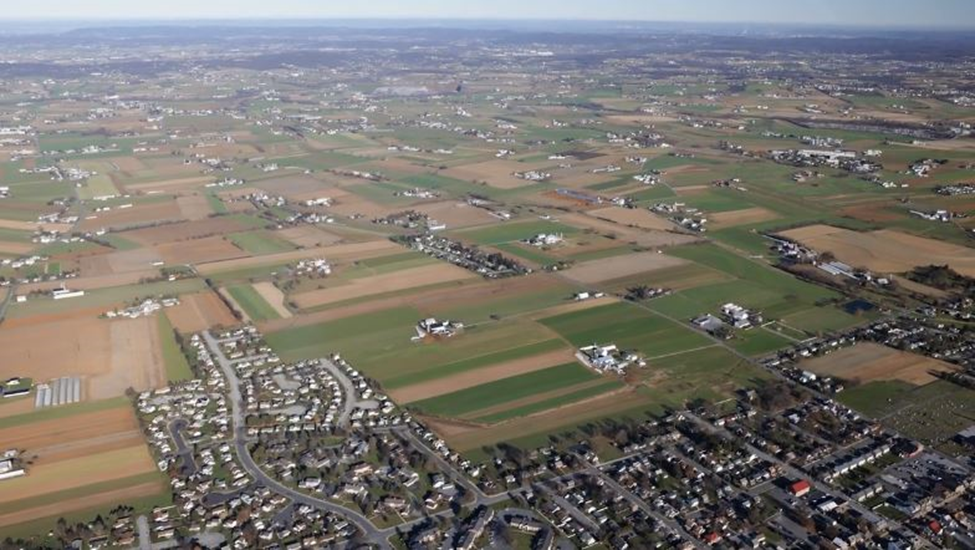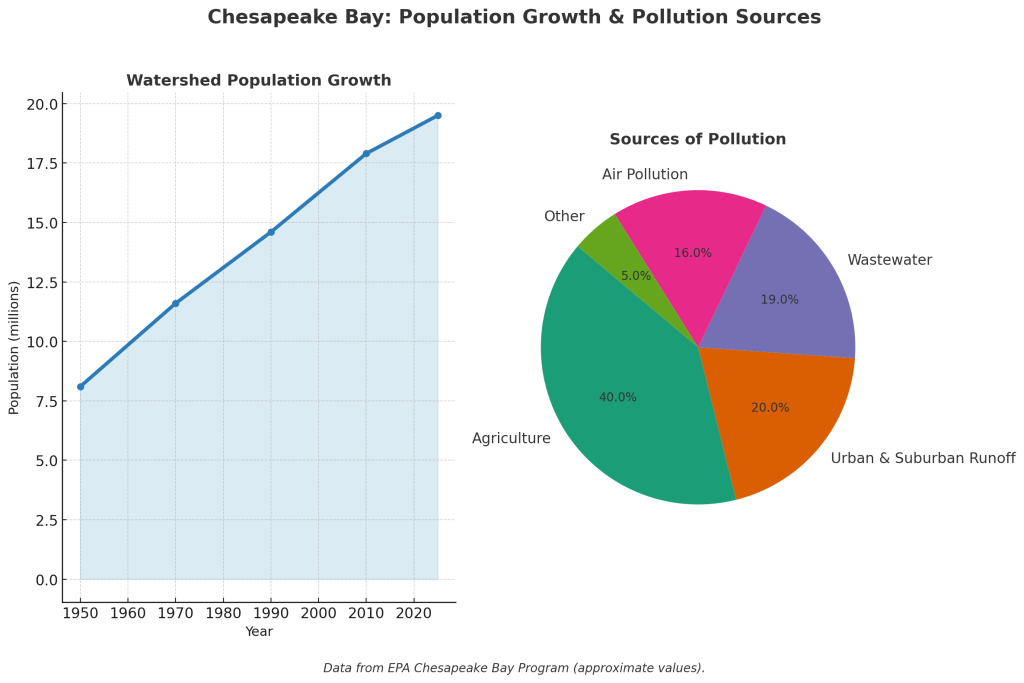Chesapeake Bay is the largest estuary in the United States. Its vast watershed (the area of land that drains to the Bay) of 64,000 square miles supports immense biodiversity. The Bay’s watershed spans parts of six states, including most of Maryland and Virginia, parts of Delaware, New York, Pennsylvania and West Virginia, and the entirety of Washington, D.C.

Throughout history, the Bay and its tributaries have provided a wide array of human benefits such as food, beauty, navigation, and trade. Unfortunately, the loss of wetlands and the sheer volume of human waste has overwhelmed the assimilative capacity of Chesapeake Bay, which suffers from poor water quality. The loss of millions of acres of upland habitat has greatly decreased wildlife populations during this same time.
According to U.S. Census data, population exploded in the area between 1950 and 2010, as the watershed’s population more than doubled–from 9 million to over 17 million. This rapid growth led to extensive development pressures and subsequent water quality degradation of the Bay. Today the watershed population stands at 19.4 million and is projected to grow to 20 million over the next five years (2030). At projected growth rates, the region’s population is expected to increase by more than one million people every 10 years.
Much of this population growth can be attributed to historically-high immigration rates. According to the U.S. Census, by 2060 our nation will grow to a whopping 385 million, with almost all growth (about 90%) due to immigration.
As is true for other vulnerable ecosystems throughout the U.S., Chesapeake Bay would greatly benefit from an end to population growth. With every new resident comes additional infrastructure — roads, homes, parking lots, and commercial development — along with more stormwater runoff and sewage effluent.

Over the past five decades, new development has laid millions of acres of concrete and asphalt across the region, along with millions of new buildings. Such impervious areas only concentrate and convey contaminated stormwater runoff. They also replace natural filters like forests and wetlands that would otherwise absorb nutrients and pollutants before they reach tributaries flowing into the Bay.
All this, combined with increased point discharges from sewage treatment plants and factories, has led to dire consequences for the bay. Excessive nutrients like nitrogen and phosphorus flow into the Bay, promoting algal blooms that deplete oxygen, harm underwater life, and create “dead zones.”
Chesapeake Bay’s water quality problems have everything to do with the rapid population growth that has happened, especially since the 1980s, throughout the Bay’s surrounding watershed. The constant expansion of human numbers and activities in the watershed clearly is thwarting the Bay’s recovery.
NumbersUSA published our first study of immigration-driven sprawl in the Chesapeake Bay area way back in 2003. We are finishing up a new study of the area that we plan to publish later this fall. Among its preliminary findings are the following:
* Population in the Chesapeake Bay region grew during the period of the study from 15,922,933 in 1982 to 21,860,969 in 2017, for an increase of 5,938,036 (a 37% increase).
* Land lost to development during this period equaled 3,228,600 acres (5,045 square miles) (a 71% increase in area of CBW developed land in the 35 years from 1982 to 2017).
* If the 0.91% annual rate of CBW population growth that prevailed over the 1982 to 2017 period were extrapolated out to 2100, by 2100 the CBW would have a population of 46,366,949, up from 21,860,969 in 2017.
* If this population growth occurs and the 2017 rate of per capita developed land consumption of 0.36 acre/person holds constant, the total area of developed land in the CBW would increase to 16,692,102 acres (26,081 square miles) in 2100, up from 7,765,800 acres (12,134 square miles) in 2017.
In addition to best farming practices, prudent land-use planning, stormwater mitigation, and wetlands reclamation, reducing immigration is essential for restoring Chesapeake Bay. Ending the region’s population growth would allow ecological restoration projects to take hold and succeed, and would go a long way in helping state and local governments safeguard the bay’s water quality and biodiversity.
The leaders of the six watershed states (plus Washington, D.C.) and their citizens should acknowledge that endless population growth ultimately will render recovery efforts futile. Chesapeake Bay is yet another reason why our leaders at the federal level should stop ignoring the obvious — population growth drives environmental degradation. The first order of business is to reduce our unsustainable (post-1965) immigration rates.

The Chesapeake Bay Program — a coalition of state and federal bureaus — has drafted a revised plan to restore the Bay and its watershed. The Program is accepting public comments on the Draft Revised Agreement until 9/1/25. Comments should be submitted via email to comments@chesapeakebay.net. This is a perfect opportunity to demand that population growth be treated as a fundamental threat to Chesapeake Bay and its environs, and to advocate for reducing immigration to end that growth.
During this Congress, NumbersUSA is promoting immigration policies to humanely reduce immigration — our Six Great Solutions. For example, one solution is the recently-introduced Nuclear Family Priority Act (H.R.2705 / S.1328) which limits family-sponsored immigration to immediate family members. NumbersUSA encourages you to contact your Congressional Representatives and Senators to support these bills to protect the Chesapeake Bay and other priceless, endangered ecosystems across the U.S.